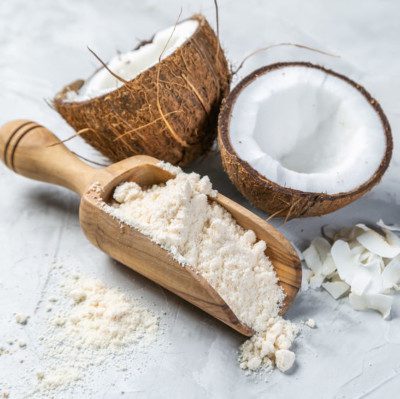Commercial production
Coconut flour is made by milling dried/desiccated coconut endosperm (copra). The oil is removed by pressing and/or solvent extraction and the remaining coconut meal is milled into fine flour. Virgin coconut meal, on the other hand, is obtained after removal of virgin coconut oil from fresh coconut meat.1
Composition
This flour contains:
- 3.6% moisture
- 3.1% ash
- 10.9% fat
- 12.1% protein
- 60.9% total dietary fiber (56.8% insoluble and 3.8% soluble)
- 70.3% carbohydrates
Function
Coconut flour is a dietary fiber which can improve the nutritional value of baked products. It can also be used to decrease glycemic index or as a high-grade protein source in baked goods. Using this flour up to 15% in bakery formulations can lower gumminess and chewiness and improve texture. Cake baked with 10% coconut flour performed better than control in sensory testing. Increased concentration of coconut flour can impact the product’s color.2
Nutrition
Coconut flour is rich in dietary fiber upon which fermentation can produce short chain fatty acids such as butyrate, acetate and propionate. Coconut flour fiber content is higher than in oat bran (8.3%) and flax seed (28%). It is also rich in proteins containing lysine, arginine, and glutamic acid. It can also provide a number of benefits related to coronary heart disease, cancer, etc.2
Applications3,4
The flour can be used in:
- Biscuits to improve protein and dietary fiber value economically
- Wheat bread formulations (10-20%) with acceptable sensory and nutritional profiles
- Functional foods to increase their nutritional value
- Breads, pies, cookies, cakes and desserts
FDA regulation
21CFR101.12 delineates the regulations for reference amounts that are consumed per eating occasion. Coconut flour quantities are to be labelled as _tbsp(s) (_g); _cup (_g).
References
- Srivastava, Y. “Effect of virgin coconut meal (VCM) on the textural, thermal and physico chemical properties of biscuits.” Food and Nutrition Sciences 1(02).2010 pp. 38.
- Trinidad, Trinidad P., Aida C. M, Divinagracia H. V, Anacleta S. L, Faridah C. A, Joan C. C, Rosario R. E, Dina B. M, Angelica S. M, and Modesto T. C. “Dietary fiber from coconut flour: A functional food.” Innovative food science & emerging technologies 7(4).2006. pp 309-317.
- Srivastava, Y, and Anil D.S.. “Effect of virgin coconut meal (VCM) on the rheological, micro-structure and baking properties of cake and batter.” Journal of food science and technology 52(12).2015 pp 8122-8130.
- Chandrashekar, S, Jeyarani T, and Indrani D. “Effect of partially defatted coconut flour on the rheological, physico‐sensory characteristics and fatty acid profile of no‐added fat rusk.” International Journal of Food Science & Technology, 2019.

